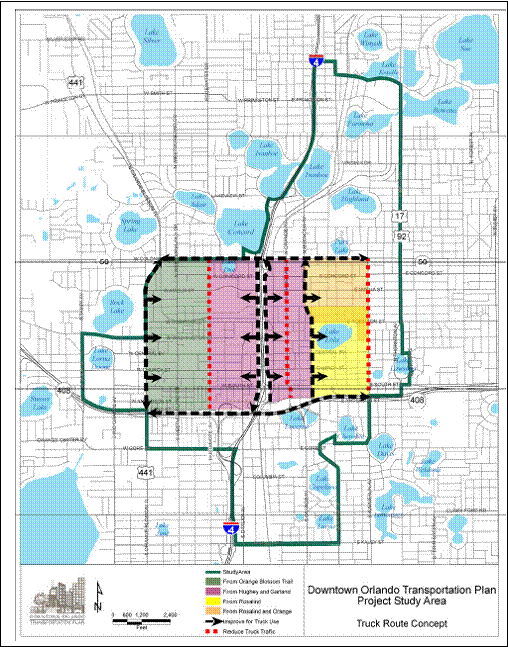| Skip
to content |
|
Urban Freight Case Studies - OrlandoDowntown Orlando Truck Route Designation SystemBased on its Downtown Orlando Transportation Master Plan, the City of Orlando designated a system of truck and truck-restricted routes. The goal of the plan is to funnel truck traffic onto a few north-south facilities in order to minimize impacts on the downtown system and to better match infrastructure to freight transportation demand. The City designated four downtown roads as truck routes and required drivers to use one of the routes (SR 50, SR 408, US 441/Orange Blossom Trail, Rosalind/Magnolia Avenue) to reach the north-south road that is closest to their destination. Once on a designated downtown truck routes, trucks must travel as close to their delivery or pick-up location as possible before they may turn onto an east-west street, thus minimizing east-west travel. Figure 2 illustrates the City of Orlando's truck route system. Figure 2: City of Orlando Truck Route System
Source: The City of Orlando Public Works Department, The Downtown Orlando Transportation Plan: Final Report (Orlando, FL: 2006), figure 6-6. This system of truck routes also better matches infrastructure and traffic operations to commercial vehicle characteristics and infrastructure improvements such as larger turning radii and lane widths. Signal timing on these routes is designed to meet the needs of commercial vehicles by increasing the yellow and green signal phases to meet increased acceleration and deceleration requirements. Prior to Orlando's route designation, City roads accommodated trucks, passenger vehicles, pedestrians, and other modes of highway transportation. By restricting trucks from using several routes, the City can better meet the needs of other modes of travel in the downtown area. Cost/Benefit of Policy ChangesAlthough policy changes require no direct financial investment, the implementation of design standards, zoning classifications, and truck route designations calls for a great deal of effort and careful planning. For example, the development of a successful Freight Village requires planners to analyze the area to determine the best location for facilities. In addition, zoning classification conducive to improved goods movement requires similar analysis to identify and enhance the freight-carrying capacity of major truck routes. The potential economic benefit of implementing these new policies makes the investment of time and resources worthwhile. With many regions experiencing increased population growth, steps must be taken to plan transportation system improvements. The addition of policies and concepts as described above is one way for government agencies to help sustain and improve their economic vitality. TransferabilityAny jurisdiction, regardless of size, has the ability to develop a set of rules and policies that ensure future development does not impede the flow of goods. Each community has different characteristics and, therefore, different transportation needs. Smaller jurisdictions with less money to spend on capital-intensive projects can add freight-conscious policies into a comprehensive freight plan, while larger jurisdictions with greater populations and greater freight movement concerns may undertake larger projects. previous | table of contents |next |
|
United States Department of Transportation - Federal Highway Administration |
||